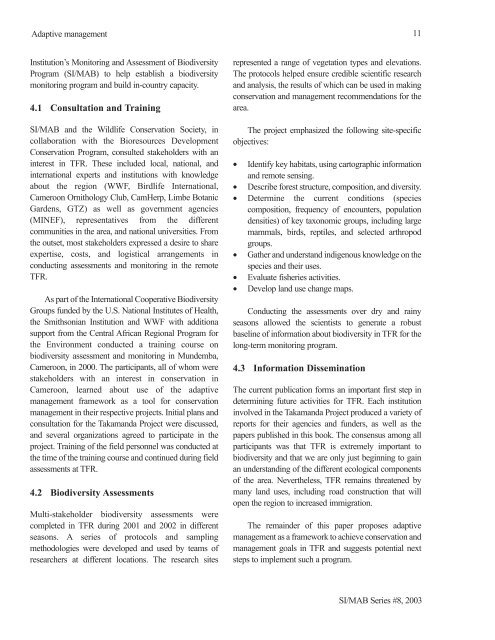Fisheries in the Southern Border Zone of Takamanda - Impact ...
Fisheries in the Southern Border Zone of Takamanda - Impact ...
Fisheries in the Southern Border Zone of Takamanda - Impact ...
Create successful ePaper yourself
Turn your PDF publications into a flip-book with our unique Google optimized e-Paper software.
Adaptive management<br />
Institution’s Monitor<strong>in</strong>g and Assessment <strong>of</strong> Biodiversity<br />
Program (SI/MAB) to help establish a biodiversity<br />
monitor<strong>in</strong>g program and build <strong>in</strong>-country capacity.<br />
4.1 Consultation and Tra<strong>in</strong><strong>in</strong>g<br />
SI/MAB and <strong>the</strong> Wildlife Conservation Society, <strong>in</strong><br />
collaboration with <strong>the</strong> Bioresources Development<br />
Conservation Program, consulted stakeholders with an<br />
<strong>in</strong>terest <strong>in</strong> TFR. These <strong>in</strong>cluded local, national, and<br />
<strong>in</strong>ternational experts and <strong>in</strong>stitutions with knowledge<br />
about <strong>the</strong> region (WWF, Birdlife International,<br />
Cameroon Ornithology Club, CamHerp, Limbe Botanic<br />
Gardens, GTZ) as well as government agencies<br />
(MINEF), representatives from <strong>the</strong> different<br />
communities <strong>in</strong> <strong>the</strong> area, and national universities. From<br />
<strong>the</strong> outset, most stakeholders expressed a desire to share<br />
expertise, costs, and logistical arrangements <strong>in</strong><br />
conduct<strong>in</strong>g assessments and monitor<strong>in</strong>g <strong>in</strong> <strong>the</strong> remote<br />
TFR.<br />
As part <strong>of</strong> <strong>the</strong> International Cooperative Biodiversity<br />
Groups funded by <strong>the</strong> U.S. National Institutes <strong>of</strong> Health,<br />
<strong>the</strong> Smithsonian Institution and WWF with additiona<br />
support from <strong>the</strong> Central African Regional Program for<br />
<strong>the</strong> Environment conducted a tra<strong>in</strong><strong>in</strong>g course on<br />
biodiversity assessment and monitor<strong>in</strong>g <strong>in</strong> Mundemba,<br />
Cameroon, <strong>in</strong> 2000. The participants, all <strong>of</strong> whom were<br />
stakeholders with an <strong>in</strong>terest <strong>in</strong> conservation <strong>in</strong><br />
Cameroon, learned about use <strong>of</strong> <strong>the</strong> adaptive<br />
management framework as a tool for conservation<br />
management <strong>in</strong> <strong>the</strong>ir respective projects. Initial plans and<br />
consultation for <strong>the</strong> <strong>Takamanda</strong> Project were discussed,<br />
and several organizations agreed to participate <strong>in</strong> <strong>the</strong><br />
project. Tra<strong>in</strong><strong>in</strong>g <strong>of</strong> <strong>the</strong> field personnel was conducted at<br />
<strong>the</strong> time <strong>of</strong> <strong>the</strong> tra<strong>in</strong><strong>in</strong>g course and cont<strong>in</strong>ued dur<strong>in</strong>g field<br />
assessments at TFR.<br />
4.2 Biodiversity Assessments<br />
Multi-stakeholder biodiversity assessments were<br />
completed <strong>in</strong> TFR dur<strong>in</strong>g 2001 and 2002 <strong>in</strong> different<br />
seasons. A series <strong>of</strong> protocols and sampl<strong>in</strong>g<br />
methodologies were developed and used by teams <strong>of</strong><br />
researchers at different locations. The research sites<br />
represented a range <strong>of</strong> vegetation types and elevations.<br />
The protocols helped ensure credible scientific research<br />
and analysis, <strong>the</strong> results <strong>of</strong> which can be used <strong>in</strong> mak<strong>in</strong>g<br />
conservation and management recommendations for <strong>the</strong><br />
area.<br />
The project emphasized <strong>the</strong> follow<strong>in</strong>g site-specific<br />
objectives:<br />
• Identify key habitats, us<strong>in</strong>g cartographic <strong>in</strong>formation<br />
and remote sens<strong>in</strong>g.<br />
• Describe forest structure, composition, and diversity.<br />
• Determ<strong>in</strong>e <strong>the</strong> current conditions (species<br />
composition, frequency <strong>of</strong> encounters, population<br />
densities) <strong>of</strong> key taxonomic groups, <strong>in</strong>clud<strong>in</strong>g large<br />
mammals, birds, reptiles, and selected arthropod<br />
groups.<br />
• Ga<strong>the</strong>r and understand <strong>in</strong>digenous knowledge on <strong>the</strong><br />
species and <strong>the</strong>ir uses.<br />
• Evaluate fisheries activities.<br />
• Develop land use change maps.<br />
Conduct<strong>in</strong>g <strong>the</strong> assessments over dry and ra<strong>in</strong>y<br />
seasons allowed <strong>the</strong> scientists to generate a robust<br />
basel<strong>in</strong>e <strong>of</strong> <strong>in</strong>formation about biodiversity <strong>in</strong> TFR for <strong>the</strong><br />
long-term monitor<strong>in</strong>g program.<br />
4.3 Information Dissem<strong>in</strong>ation<br />
The current publication forms an important first step <strong>in</strong><br />
determ<strong>in</strong><strong>in</strong>g future activities for TFR. Each <strong>in</strong>stitution<br />
<strong>in</strong>volved <strong>in</strong> <strong>the</strong> <strong>Takamanda</strong> Project produced a variety <strong>of</strong><br />
reports for <strong>the</strong>ir agencies and funders, as well as <strong>the</strong><br />
papers published <strong>in</strong> this book. The consensus among all<br />
participants was that TFR is extremely important to<br />
biodiversity and that we are only just beg<strong>in</strong>n<strong>in</strong>g to ga<strong>in</strong><br />
an understand<strong>in</strong>g <strong>of</strong> <strong>the</strong> different ecological components<br />
<strong>of</strong> <strong>the</strong> area. Never<strong>the</strong>less, TFR rema<strong>in</strong>s threatened by<br />
many land uses, <strong>in</strong>clud<strong>in</strong>g road construction that will<br />
open <strong>the</strong> region to <strong>in</strong>creased immigration.<br />
The rema<strong>in</strong>der <strong>of</strong> this paper proposes adaptive<br />
management as a framework to achieve conservation and<br />
management goals <strong>in</strong> TFR and suggests potential next<br />
steps to implement such a program.<br />
11<br />
SI/MAB Series #8, 2003

















